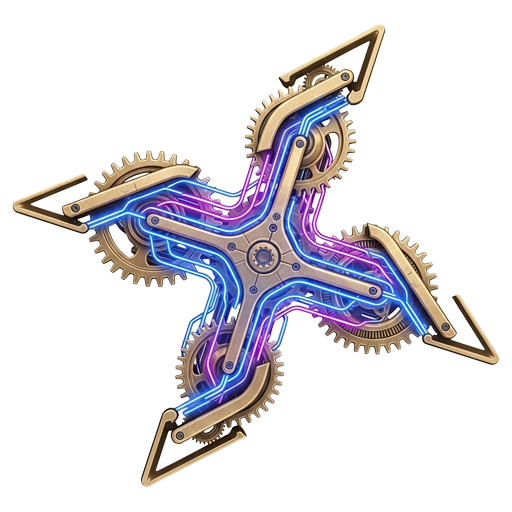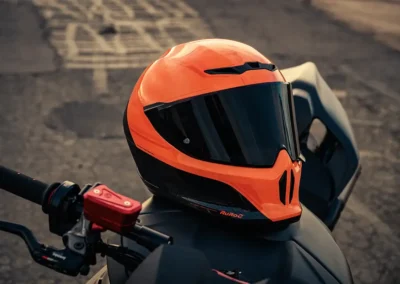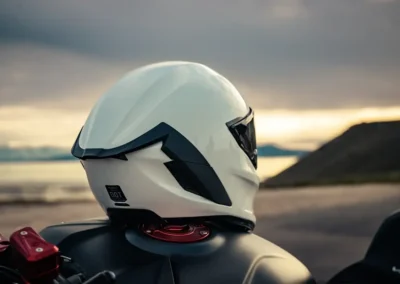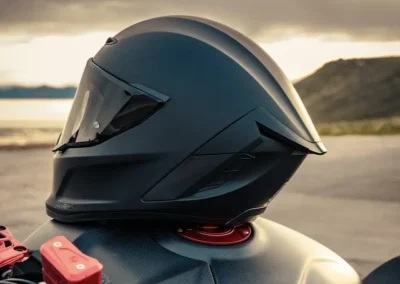Gloucester, England – Ruroc has moved beyond its established ATLAS platform with the introduction of the EOX helmet. Engineered with a clear intent to address the shortcomings of its predecessors, the EOX integrates a new shell composition, refined aerodynamics, and a fundamentally redesigned communication system. This analysis examines the helmet’s core components and performance metrics, based on manufacturer specifications and independent evaluations, to determine its position in the premium helmet market.
Shell Composition and Safety Metrics
The foundation of the EOX is its Quad-Matrix composite shell, a blend of T300 carbon fiber, Kevlar, nylon, and fiberglass. This multi-material approach is designed to optimize energy absorption and penetration resistance while managing weight. Ruroc claims the EOX shell is 5% lighter than the previous ATLAS 4.0 Carbon model. Independent testing confirms a weight of approximately 1601 grams for a size large, placing it in the median range for its category.
For impact protection, the helmet utilizes a multi-density liner combining expanded polystyrene (EPS) and expanded polypropylene (EPP) to manage low, medium, and high-energy impacts. Integrated into the headliner is Rheon, a non-Newtonian polymer engineered to provide additional absorption of both linear and rotational forces.
This construction has earned the EOX dual homologation under ECE 22.06 and DOT FMVSS 218 standards. Furthermore, it has achieved a 4-star rating from the independent SHARP testing program in the UK, a transparent indicator of its protective capabilities.

Aerodynamic and Thermal Performance
A significant focus in the EOX’s development was aerodynamic stability. The shell’s form, including a redesigned rear spoiler and smoother contours, is a departure from the more aggressive lines of the ATLAS series. Ruroc quantifies the result as a 37% improvement in angular velocity magnitude (a measure of stability) when compared to the ATLAS 4.0 TRACK model. Subjective reports from various riders confirm a noticeable reduction in buffeting at highway speeds.
Ventilation has been systematically overhauled. The system comprises six vents—four intake and two exhaust—with channeled EPS to direct airflow. The manufacturer claims a 110% improvement in thermal performance over the ATLAS 4.0 Carbon. While this specific figure is difficult to verify without laboratory conditions, reviews consistently note effective cooling, particularly from the two large top vents. However, some evaluations have reported an audible whistle from these top vents when open, particularly in a tucked riding position.
Optics and Ergonomics
The EOX provides a field of view measuring 215° horizontally and 100° vertically. The optically correct visor ships with both a clear and a dark smoke lens, as well as a Pinlock 120 insert for anti-fogging. The new tool-less visor change mechanism has been timed at under five seconds, though some testers have described the multi-position detent system as feeling less refined than those on other premium helmets.
The helmet’s fit is classified as an intermediate oval. It is constructed in three distinct shell sizes across its XS-XL range to maintain a proportional profile. Each helmet ships with a standard and a “Slimline” set of cheek pads to offer a degree of fit customization. The liner itself is a moisture-wicking peached jersey material.
A notable departure from traditional retention systems is the continued use of the Fidlock magnetic chin strap. While it allows for one-handed operation, even with gloves, it presents a learning curve for users accustomed to double D-ring or ratchet systems.
Integrated Communications
In a direct response to feedback on previous models, the EOX integrates a communications system powered by Cardo. The optional Shockwave Mesh unit is now side-mounted, with the controller on the left and a separate battery pack on the right. This allows for mesh connectivity with up to 15 riders over a claimed 1.2 km range. The system uses speakers from Harman Kardon, and installation is streamlined due to pre-molded pockets and wiring channels within the helmet structure.
The Ruroc EOX is a purpose-built evolution, substantiated by quantifiable improvements in safety certification, aerodynamic stability, and thermal regulation when compared to its own lineage. The Quad-Matrix shell, inclusion of Rheon, and a 4-star SHARP rating provide a solid foundation of protection. The integration of a Cardo-based mesh communication system rectifies a significant functional deficiency of its predecessors.
However, certain elements detract from a flawless execution. Reports of wind noise from the upper vents and critiques of the visor mechanism’s tactile feel indicate areas for refinement. The choice of the Fidlock closure system remains a point of user preference rather than objective superiority. The EOX presents a compelling technical package, demonstrating a direct response to empirical data and user feedback, positioning it as a formidable contender for the purpose-driven rider.


















